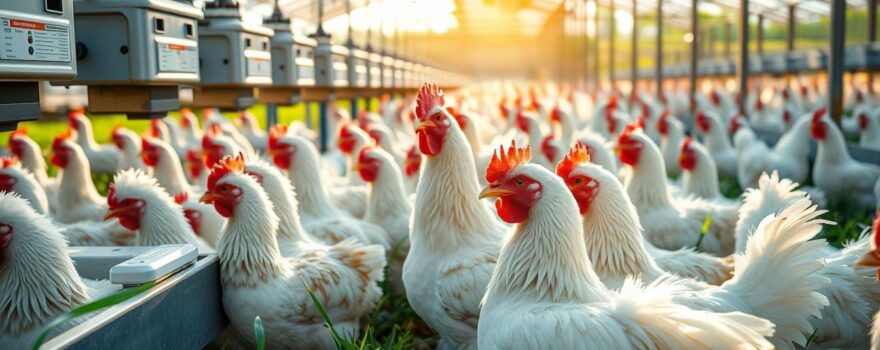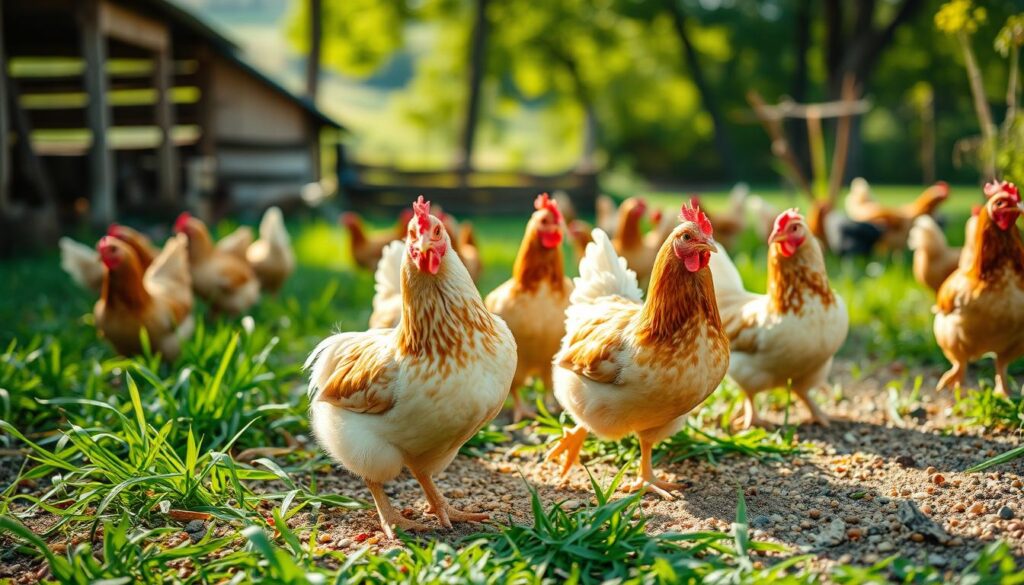
In the world of commercial poultry farming, making broilers grow better is key. This is because more people want to eat chicken. So, finding new ways to feed broilers is very important.
This article talks about the latest in feeding broilers. We look at how to make their food better and how to help them grow. We also talk about keeping them healthy and using special diets without antibiotics.
It’s all about how to make broilers grow fast and strong. We’ll share tips on how to feed them right. This will help producers keep up with the changing needs of broiler farming.
Key Takeaways
- Optimize feed formulation and nutrient density for enhanced broiler performance
- Leverage specialized nutrition strategies to support early chick development and intestinal health
- Employ precision feeding techniques to fuel rapid growth and maximize feed conversion efficiency
- Overcome nutrition-related obstacles through innovative solutions and technology-driven approaches
- Embrace sustainable and ethical nutrition practices to prioritize broiler welfare and responsible sourcing
The Importance of Nutrition in Broiler Growth
Nutrition is key for broiler chickens to grow well. Poultry farmers need to use the right feed strategies for health and productivity. Knowing how nutrition affects broilers helps farmers get the best results.
Nutritional Impacts on Health, Vitality, and Productivity
Broilers need a lot of protein in their diet. Finding the right amount of protein is important for their performance. Soybean meal and animal proteins are crucial for their growth.
Also, the rapidly growing nature of broilers highlights the need for advancements in nutrition to sustain their rapid growth. As broilers grow faster, their nutritional needs change. Farmers must adjust their feed to meet these changes.
The Role of Tailored Feed Strategies in Broiler Farming
Broiler farmers need to adjust their feed to get the best results. They use new research on amino acids and additives to improve feed. Tailored feed helps support broiler health at every stage.
| Nutrition Aspect | Key Insights |
|---|---|
| Protein Sources |
|
| Nutrient Management |
|
By using tailored broiler nutrition strategies, farmers can improve broiler health and productivity. This leads to consistent, high-quality poultry feed strategies. It helps the industry grow sustainably.
Nurturing Early Development with Specialized Nutrition
The early life of a broiler, from embryo to chick, is key for healthy growth. Giving the right nutrition during this time is vital. It helps ensure the chicks grow strong and healthy.
Optimizing Embryonic and Chick Nutrition
Broilers spend a big part of their life, 30% to 40%, inside the egg. Specialized nutrition is needed for proper growth during this time. Heat stress during this stage can harm the chick’s health and growth.
Feeding chicks a diet rich in fiber helps their gut health. It also boosts their performance. Choosing breeds that can handle heat better is also important. These birds do better in hot temperatures.
Laying the Foundation for Robust Broiler Chicks
- Early nutrition after hatching greatly affects broiler chicken growth and efficiency. A 10-gram weight gain at 7 days can mean a 50-70 gram gain at 42 days.
- Knowing how vital organs and metabolism change in chicks is key for better performance.
- Using pre-initial feeds for broiler chickens is now common. It helps in raising strong chicks.
By focusing on the right nutrition for embryos and chicks, farmers can help them grow well. This sets the stage for healthy, high-performing broiler chickens.
| Parameter | Impact |
|---|---|
| Chick Weight at Hatch | Significant effect on weights at 21 and 42 days of age |
| Early Nutrition After Hatching | 10-gram weight gain at 7 days leads to 50-70 gram gain at 42 days |
| Vital Organ Development | Crucial for improving broiler chick performance |
Fueling Rapid Growth with Precision Nutrition
The starter phase of broiler growth is fast-paced. Precision nutrition is key to fueling this growth. Broiler farmers must know the exact nutritional needs of developing broilers to support their rapid growth.
Feed makes up about 65% of chicken meat production costs. This makes precise nutrition and feeding crucial. It helps keep poultry affordable for a growing world population. Rising feed costs and shortages of amino acids and micronutrients have made precision nutrition even more important.
Precision feeding and nutrition improve production efficiency, nutrient utilization, animal health, well-being, and reduce environmental pollution. Broiler farmers can ensure their flock gets the right nutrients by monitoring and adjusting feed. This supports their rapid growth and development during the starter phase.
Optimizing Nutrient Sensing and Utilization
Research shows that nutrient sensors in chickens’ guts change a lot from 7 to 26 days after hatching. At day 7, there’s more amino acid sensors in the mouth and fatty acid sensors in the lower gut than in the middle. The upper gut has more amino acid sensors than fatty acid sensors in both 7 and 26-day-old chickens.
Studies found positive links between different nutrient sensing genes in chickens. Knowing these changes helps broiler farmers tailor their precision broiler feeding to better use nutrients. This supports rapid broiler growth in the starter phase.
| Key Findings on Broiler Nutrient Sensing |
|---|
|
By using these insights and broiler starter phase nutrition strategies, farmers can improve nutrient use. This supports the unique needs of broilers and drives rapid growth in this critical stage.
Adapting Feed Strategies for the Growing Broiler
Broiler chickens grow fast as they enter their adolescent phase. Their diet needs change to support this rapid growth. This section looks at how to adjust their feed to meet these new needs.
Nutritional Considerations for the Adolescent Phase
Broilers grow quickly and need more energy during this stage. Broiler adolescent nutrition must be carefully planned. It should help with muscle growth, bone strength, and overall health. Feed adjustments, like protein and mineral levels, are key to supporting this growth.
Growth-Oriented Practices for Transitioning Broilers
- Use feed strategies for growing broilers that focus on weight gain and efficiency.
- Apply precision feeding to better deliver nutrients during the broiler transition phase.
- Adjust lighting to improve growth-focused broiler nutrition and flock performance.
By changing feed strategies and using proven practices, producers can help their broilers grow well. This ensures a smooth transition and continued growth.
| Metric | Conventional Feeding | Precision Feeding |
|---|---|---|
| Feed Conversion Ratio | 1.65 | 1.55 |
| Carcass Yield | 72% | 74% |
| Growth Rate | 55 g/day | 58 g/day |

“Precision feeding techniques have shown to boost feed efficiency and carcass yield in growing broilers. This proves the value of customized nutrition plans during the adolescent phase.”
Advanced Nutrition Strategies for Maximizing Broiler Chicken Growth
Advanced nutrition strategies are key for top broiler performance. By carefully making feed and adjusting nutrients, farmers can help their chickens grow better. This method includes precise feeding, smart feed use, and caring for the whole flock to boost productivity and profits.
Water is very important in this strategy. Birds need 70-80 percent of their daily water from drinking. Having clean, good water is vital for their health, growth, and performance.
Managing litter well is also crucial. A higher stocking density of poultry can negatively impact performance. Adequate litter management is crucial for broiler intestinal health and profitability. Farmers must watch litter conditions and use effective methods to support the birds’ health and growth.
| Nutrition Strategy | Impact |
|---|---|
| Precise Feed Formulations | Optimizes nutrient profiles for maximum growth |
| Strategic Feed Management | Reduces feed wastage and ensures consistent access |
| Holistic Flock Management | Supports overall health and well-being for optimal performance |
By using these advanced broiler nutrition strategies, farmers can maximize broiler growth and optimize broiler performance. A complete approach that looks at nutrition and environment helps unlock the full potential of broiler flocks. This leads to lasting success in the poultry industry.
Optimizing Feed Formulations for Peak Performance
As broilers grow into adulthood, it’s key to fine-tune their feed. This ensures they reach their full potential. Broiler farmers can boost their flock’s productivity and health with advanced feed strategies.
Fine-Tuning Feed Content for Optimal Broiler Growth
Today’s feed formulas often focus on saving money, not making more. But new models will aim to increase profits. They’ll look at how much meat is produced and the costs of feed, housing, and processing.
As technology gets better, feed formulas will get smarter. They’ll move from simple energy systems to more complex ones. This will help reduce heat loss and make nutrient delivery more precise and efficient.
Maximizing Broiler Size, Weight, and Overall Health
Using more enzymes and understanding feed ingredients better will be key. Also, improving how we measure amino acids will help make better feed. This will lead to more accurate and effective nutrition for broilers.
By focusing on all amino acids, not just the essential ones, farmers can give their birds what they need. This approach helps keep costs down while supporting the birds’ health and performance.

“The development of profit-maximizing models will center on the production functions of broilers and layers, ensuring that the most profitable output levels are achieved.”
Nutritional Practices for the Final Growth Stage
As broilers near maturity, the right nutrition is key. This part looks at how to feed them for the best growth. It’s about getting them to the right weight and keeping them healthy. This ensures they’re ready for market.
Targeted Strategies for Achieving Ideal Weight
Broiler farmers need to focus on feed that helps birds grow fast. Recent studies have shown that weight gain and absolute organ weight showed significant improvements in the CMT-II group compared to the CMT-0 group. Adjusting the feed’s nutrients and calories is crucial for their growth.
Supporting Muscle Development and Well-Being
The final stage also means paying attention to muscle and health. Serum IgG level was significantly improved in CMT-I compared with CMT-0, indicating enhanced immune function. Beneficial taxa, such as Firmicutes and Verrucomicrobiota, were substantially more abundant in both CMT-I and CMT-II than in CMT-0, suggesting improved gut health and resilience. Good nutrition supports muscle growth and boosts health.
| Key Metrics | CMT-0 Group | CMT-I Group | CMT-II Group |
|---|---|---|---|
| Weight Gain | – | – | Significant Improvement |
| Organ Weight | – | – | Significant Improvement |
| Serum IgG Level | – | Significant Improvement | – |
| Beneficial Taxa (Firmicutes, Verrucomicrobiota) | – | Substantially More Abundant | Substantially More Abundant |
“Meat consumption trends in the USA showed an interesting peeking of the trend.”
Overcoming Nutrition-Related Obstacles
Broiler farming faces nutrition-related challenges. This section offers insights on tackling these issues. It helps farmers improve feed conversion and address nutrient deficiencies, ensuring broilers perform at their best.
Mitigating Feed Conversion Issues
Improving the feed conversion ratio (FCR) is key in broiler farming. Over the years, better diets and feeding methods have greatly improved growth and efficiency. By focusing on nutrition, gut health, and development, farmers can boost feed efficiency and reduce waste.
Addressing Nutrient Deficiencies
Broilers need a balanced diet for health and growth. Research highlights the role of protein, amino acids, vitamins, and minerals in broiler diets. Tailored feed formulations help farmers overcome nutrition challenges, ensuring their flocks reach their full growth potential.
| Nutrient | Importance in Broiler Nutrition | Common Deficiency Symptoms |
|---|---|---|
| Protein | Critical for muscle development and growth | Reduced weight gain, poor feed conversion, weakened immune system |
| Amino Acids | Essential for tissue synthesis and maintenance | Impaired growth, feathering, and immune function |
| Vitamins | Crucial for various metabolic processes and health | Bone deformities, poor feathering, reduced growth, and susceptibility to diseases |
| Minerals | Support skeletal development, enzyme function, and overall well-being | Weak bones, poor eggshell quality, impaired immune response |
By using targeted feeding strategies and innovative feed formulations, broiler farmers can overcome nutrition challenges. This ensures their flocks grow well, perform optimally, and are profitable.
Embracing Technology for Better Broiler Nutrition
Broiler farming is changing fast thanks to new technology. We’re now using precision feeding and smart feed formulas. These tools help improve how we feed broiler chickens, making them grow better and waste less.
Precision Feeding and Smart Formulations
Technology is changing broiler farming. Farmers use data to make feed just right for each chicken. This means better growth, health, and less waste.
Smart feed formulas are also becoming common. These use advanced math to create feed that meets each chicken’s needs. It boosts growth and cuts down on waste.
Enhancing Feed Efficiency and Reducing Waste
Technology is making broiler farming more efficient. It helps chickens grow faster with less food. This saves money and is better for the environment.
Technology also cuts down on feed waste. Smart sensors and systems make sure chickens get just the right amount of food. This is good for resources and the planet.
| Key Metric | 1940 | 1984 | Improvement |
|---|---|---|---|
| Cost per pound of broiler meat | 54.8 cents | 81.4 cents | 49% increase |
| Per capita consumption of broiler meat | 2.0 pounds | 53.0 pounds | 2,550% increase |
| Feed conversion ratio | 2.8 | 1.55 | 44.6% improvement |
Technology is making broiler farming better. It’s improving how we feed chickens, reducing waste, and making them healthier. As technology keeps getting better, broiler farming will become even more efficient and sustainable.
Sustainable and Ethical Nutrition Practices
In modern broiler farming, sustainable and ethical nutrition is key. The industry aims to meet growing chicken meat demand. It focuses on broiler welfare and responsible feed sourcing.
Prioritizing Broiler Welfare
Broiler welfare is central to sustainable nutrition. Farmers now focus on creating a comfortable, stress-free environment for chickens. This supports their health and growth.
This includes humane housing, clean water, and nutritious feed. It also means promoting natural behaviors like foraging and dust bathing.
- Adopting slower-growing breeds to ease animal strain
- Providing enough space and enrichment for natural behaviors
- Reducing antibiotics and using natural disease prevention
Responsible Sourcing and Feed Practices
Sustainable broiler nutrition also means responsible feed sourcing. Farmers aim to reduce environmental impact and waste. They seek to trace their feed sources.
This includes using local, non-GMO, and organic feed. They also explore alternative proteins like insects or plants. Precision feeding techniques help use nutrients better.
- Choosing locally sourced, non-GMO, and organic feed
- Looking into new protein sources to cut soy and fishmeal use
- Using precision feeding to reduce waste and improve efficiency
The broiler industry is moving towards a more responsible future. This effort benefits chickens and the environment. It ensures the industry’s long-term success and consumer trust.
This article has shown how mastering advanced nutrition strategies can change broiler farming. We looked at the importance of tailored feed, early development, and adapting feed as birds grow. These are the secrets to great success in broiler farming.
We learned that the right nutrition is key to better health and productivity in broilers. We encourage readers to use these insights to improve their farms. This will help them reach new levels of success with precise nutrition.
The broiler industry is growing, and it’s important to do it right. This article talked about using technology and making better feed. It also stressed the need to care for broilers and use responsible practices. By doing this, farmers can help make the industry better for everyone and the planet.